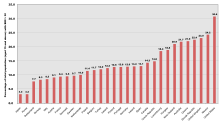Health in New Zealand
This article has multiple issues. Please help improve it or discuss these issues on the talk page. (Learn how and when to remove these template messages)
|
New Zealand is a high income country, and this is reflected in the overall good health status of the population. However like other wealthy countries New Zealand suffers from high rates of obesity and heart disease.[1]
History of New Zealander's health
Māori life expectancy dropped from about 30 years in the 18th century to 25 years for men and 23 years from women by the end of the 19th.[2] Pre-contact Māori viewed disease as a punishment for breaking tribal tapu but also recognised that some families were prone to certain disease. The standard practice of tohunga was to isolate the victim in a small shelter. The most common serious disease was tuberculosis (kohi). However, Māori did not recognise the symptoms as being from one disease. Kohi was considered the work of demons and caused by Makutu (witchcraft).[3]
Public health programs
There are public health campaigns for obesity, drinking, smoking and various vaccines.
Health care
Mental Health
Health statistics

The following statistics are a sample from the World Health Organization Statistical Information System. The year on which the data were sampled follows the statistic in brackets.
- Demographics
- Population (in thousands): 4,460 (2012)
- Total fertility rate (per woman): 2.07 (2012)
- Adolescent fertility rate (%): 27 (2004)
- Funding
- Life expectancy
- Life expectancy at birth (years): 82 (2012)
- Life expectancy for females (years): 84 (2012)
- Life expectancy for males (years): 80 (2012)
- Neonatal mortality (per 1,000 live births): 3 (2012)
- Infant mortality (per 1,000 live births): 5 (2012)
- Years of life lost to communicable diseases (%): 5 (2002)
- Years of life lost to injuries (%): 17 (2002)
- Years of life lost to non-communicable diseases (%): 79 (2002)
Life expectancy is lower for the Māori and Pacific populations by around six years.[4]
References
- ^ Streib, Lauren (8 February 2007). "World's Fattest Countries". Forbes. Retrieved 12 February 2009.
- ^ Taonga, New Zealand Ministry for Culture and Heritage Te Manatu. "Death rates and life expectancy – Te Ara Encyclopedia of New Zealand". teara.govt.nz. Retrieved 28 December 2018.
- ^ Hiroa, Te Rangi (1910). Medicine Amongst the Maoris, in Ancient and Modern Times. tuberculosis. Retrieved 11 April 2017.
{{cite book}}: CS1 maint: location missing publisher (link) - ^ "New Zealand's health service performs well, but inequities remain high". The Conversation. 20 September 2017. Retrieved 22 November 2018.
See also
